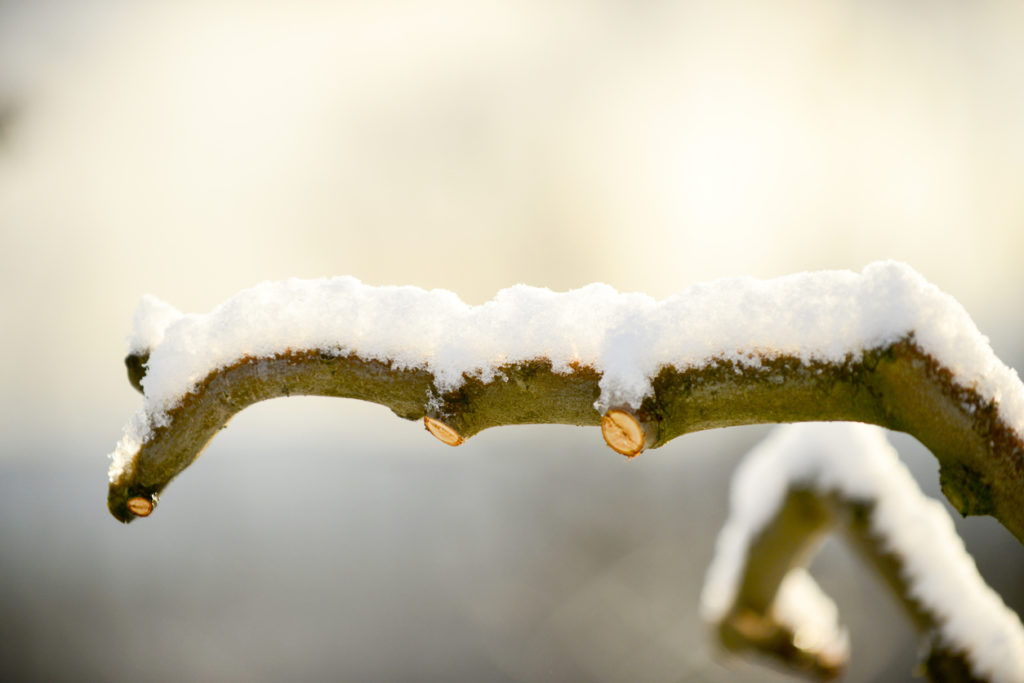Tips For Pruning In Winter

Trimming plants and shrubs is an important part of overall care, including pruning in winter. Though many plants are sheared in warmer seasons, there are some you can prune during cold weather. Read on for tips.
Why Pruning Is Important
Pruning provides many advantages throughout the seasons:
*Gives the specimen strength
*Removes diseased, damaged and insect-infested branches
*Controls plant or tree size
*Encourages flowering and fruiting
*Molds the form or growth habit
New Wood and Old
Shrubs that bloom on new wood bloom from the current year’s growth. These plants generally flower later in the growing season, and should be pruned once they are dormant and/or after the ground freezes. Plants that bloom from last year’s growth (old wood) are the ones you should prune mainly in spring and summer.
Shrubs For Cold Weather Pruning
Bushes that flower on new wood: Varieties that flower on the current year’s growth may be pruned in late winter (January – March, depending on your climate). These include Beautyberry; Bluebeard; Bush Cinquefoil; Butterfly Bush; Hardy Hibiscus, and Smokebush.
You can trim specific varieties of Hydrangea in winter- Annabelle and panicle types, such as Incrediball, Invincibelle, and PeeGee. The varieties of Spirea that benefit from late winter pruning include Neon Flash and Gold Mound.
Roses: If you grow roses, pruning is a critical part of care. Timing depends on what varieties of roses you have. Prune roses that bloom just once, such as Old-fashioned and Climbers, right after they flower. Late February pruning — just before bud break — is for repeat bloomers, such as Hybrid Teas and Floribunda Roses (also known as Modern Roses).
Never delay removing dead, damaged, diseased or discolored canes, regardless of the variety. For more tips on keeping roses properly trimmed, visit this link for a complete guide on pruning roses.
Foliage Plants: Some shrubs are considered primarily foliage plants. You can prune these in winter since there are no flower buds to consider. Examples include Barberry, Burning Bush and Ninebark.
Tools For Trimming
The best way to effective pruning is to use the tools designed for this work. Clean all tools before using them and prior to storing them.
*Hand Pruners – The bypass pruner contains a single edge blade and is by far the best tool for trimming smaller branches.
*Loppers – These can be defined as hand pruners with very large handles. Though you get better reach, the main purpose of loppers is to trim larger branches.
*Shears – Hand-operated hedge shears look like a pair of large scissors. Shears are designed to cut much larger areas than other trimming tools. They cut long, straight edges, so reserve them for maintaining formal hedges, topiaries, and for cutting perennials down to their crowns in early spring and fall.
*Hand Saws – For wood that is about 1.5 inches or thicker, you should enlist the help of a hand saw for branches reached from ground level. Sturdy work gloves and safety goggles are a must. Keep the blade straight while you cut and always keep it away from soil and sand, which will dull the blade.
For visual aids for where to make the cuts, and other tips, view this article on successful pruning.
Pruning in Winter For Plant Health
Keeping your plants healthy and performing at their best is easy to achieve with proper care, which includes pruning in winter for some plants. Pruning is easy to manage with the correct tools and when done at the appropriate time for your plants’ growing schedules. And keep the plant trimming in YOUR court. Don’t let the deer munch your shrubs down to stubs! Bobbex Deer Repellent can help with that.
